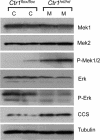A novel role for copper in Ras/mitogen-activated protein kinase signaling
- PMID: 22290441
- PMCID: PMC3302449
- DOI: 10.1128/MCB.05722-11
A novel role for copper in Ras/mitogen-activated protein kinase signaling
Abstract
Copper (Cu) is essential for development and proliferation, yet the cellular requirements for Cu in these processes are not well defined. We report that Cu plays an unanticipated role in the mitogen-activated protein (MAP) kinase pathway. Ablation of the Ctr1 high-affinity Cu transporter in flies and mouse cells, mutation of Ctr1, and Cu chelators all reduce the ability of the MAP kinase kinase Mek1 to phosphorylate the MAP kinase Erk. Moreover, mice bearing a cardiac-tissue-specific knockout of Ctr1 are deficient in Erk phosphorylation in cardiac tissue. in vitro investigations reveal that recombinant Mek1 binds two Cu atoms with high affinity and that Cu enhances Mek1 phosphorylation of Erk in a dose-dependent fashion. Coimmunoprecipitation experiments suggest that Cu is important for promoting the Mek1-Erk physical interaction that precedes the phosphorylation of Erk by Mek1. These results demonstrate a role for Ctr1 and Cu in activating a pathway well known to play a key role in normal physiology and in cancer.
Figures









Similar articles
-
Copper is required for oncogenic BRAF signalling and tumorigenesis.Nature. 2014 May 22;509(7501):492-6. doi: 10.1038/nature13180. Epub 2014 Apr 9. Nature. 2014. PMID: 24717435 Free PMC article.
-
The copper chaperone CCS facilitates copper binding to MEK1/2 to promote kinase activation.J Biol Chem. 2021 Dec;297(6):101314. doi: 10.1016/j.jbc.2021.101314. Epub 2021 Oct 27. J Biol Chem. 2021. PMID: 34715128 Free PMC article.
-
Copper influx transporter 1 is required for FGF, PDGF and EGF-induced MAPK signaling.Biochem Pharmacol. 2012 Oct 15;84(8):1007-13. doi: 10.1016/j.bcp.2012.07.014. Epub 2012 Jul 25. Biochem Pharmacol. 2012. PMID: 22842628 Free PMC article.
-
Role of Ras and Mapks in TGFbeta signaling.Cytokine Growth Factor Rev. 2000 Mar-Jun;11(1-2):23-35. doi: 10.1016/s1359-6101(99)00026-x. Cytokine Growth Factor Rev. 2000. PMID: 10708950 Review.
-
The role of Ctr1 and Ctr2 in mammalian copper homeostasis and platinum-based chemotherapy.J Trace Elem Med Biol. 2015;31:178-82. doi: 10.1016/j.jtemb.2014.03.006. Epub 2014 Mar 24. J Trace Elem Med Biol. 2015. PMID: 24703712 Free PMC article. Review.
Cited by
-
The copper transporter 1 (CTR1) is required to maintain the stability of copper transporter 2 (CTR2).Metallomics. 2015 Nov;7(11):1477-87. doi: 10.1039/c5mt00131e. Epub 2015 Jul 24. Metallomics. 2015. PMID: 26205368 Free PMC article.
-
Cisplatin inhibits MEK1/2.Oncotarget. 2015 Sep 15;6(27):23510-22. doi: 10.18632/oncotarget.4355. Oncotarget. 2015. PMID: 26155939 Free PMC article.
-
A Modular Ionophore Platform for Liver-Directed Copper Supplementation in Cells and Animals.J Am Chem Soc. 2018 Oct 24;140(42):13764-13774. doi: 10.1021/jacs.8b08014. Epub 2018 Oct 15. J Am Chem Soc. 2018. PMID: 30351140 Free PMC article.
-
Copper Metabolism of Newborns Is Adapted to Milk Ceruloplasmin as a Nutritive Source of Copper: Overview of the Current Data.Nutrients. 2018 Oct 30;10(11):1591. doi: 10.3390/nu10111591. Nutrients. 2018. PMID: 30380720 Free PMC article. Review.
-
Copper Chelation as Targeted Therapy in a Mouse Model of Oncogenic BRAF-Driven Papillary Thyroid Cancer.Clin Cancer Res. 2018 Sep 1;24(17):4271-4281. doi: 10.1158/1078-0432.CCR-17-3705. Epub 2018 Jul 31. Clin Cancer Res. 2018. PMID: 30065097 Free PMC article.
References
-
- Aoki Y, Niihori T, Narumi Y, Kure S, Matsubara Y. 2008. The RAS/MAPK syndromes: novel roles of the RAS pathway in human genetic disorders. Hum. Mutat. 29:992–1006 - PubMed
-
- Baker NE, Rubin GM. 1992. Ellipse mutations in the Drosophila homologue of the EGF receptor affect pattern formation, cell division, and cell death in eye imaginal discs. Dev. Biol. 150:381–396 - PubMed
Publication types
MeSH terms
Substances
Grants and funding
LinkOut - more resources
Full Text Sources
Molecular Biology Databases
Research Materials
Miscellaneous
